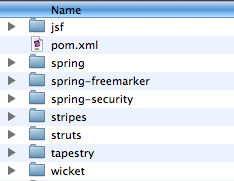Last night I spent an hour upgrading AppFuse to Hibernate 3.4.0.GA. I tried the same thing a week ago, but failed miserably. When Hibernate Core Modules (3.3) (a Maven dependency howto) showed up on the Hibernate blog, I was re-inspired. I discovered some interesting things along the way (at least in my setup).
You need to use JBoss's Maven Repository
The latest Hibernate releases aren't in the central Maven repo yet. If they're not in there two weeks after the release, I doubt they'll be there anytime soon. Best to plan on adding http://repository.jboss.com/maven2 as a permanent repository. As a bonus, you can remove http://download.java.net/maven/2 since JTA is in JBoss's repo.
Javassist is not an optional dependency
If I remove the Javassist dependency, here's the error I get:
java.lang.NoClassDefFoundError: javassist/util/proxy/MethodFilter
Seems reasonable right? What if I add in the dependency on Hibernate's cglib instead?
java.lang.NoClassDefFoundError: javassist/util/proxy/MethodFilter
OK, so apparently you can't switch between Javassist and hibernate-cglib-repack as stated in Hibernate's Maven dependency howto. Of course, I do believe their instructions are correct, they just don't work in my setup. Versions I'm using: hibernate-core-3.3.1.GA and hibernate-annotations-3.4.0.GA.
Not including SLF4J is a bad idea
If you don't include a dependency on SLF4J (and you're using Spring), you get a nice cryptic error message.
Caused by: org.springframework.beans.BeanInstantiationException: Could not instantiate bean class
[org.springframework.orm.hibernate3.annotation.AnnotationSessionFactoryBean]:
Constructor threw exception; nested exception is java.lang.NoClassDefFoundError
at org.springframework.beans.BeanUtils.instantiateClass(BeanUtils.java:115)
at org.springframework.beans.factory.support.SimpleInstantiationStrategy.instantiate(SimpleInstantiationStrategy.java:61)
at org.springframework.beans.factory.support.AbstractAutowireCapableBeanFactory.instantiateBean(AbstractAutowireCapableBeanFactory.java:877)
... 48 more
Caused by: java.lang.NoClassDefFoundError
at java.lang.Class.forName0(Native Method)
at java.lang.Class.forName(Class.java:164)
at org.springframework.orm.hibernate3.LocalSessionFactoryBean.class$(LocalSessionFactoryBean.java:174)
at org.springframework.orm.hibernate3.LocalSessionFactoryBean.(LocalSessionFactoryBean.java:174)
at org.springframework.orm.hibernate3.annotation.AnnotationSessionFactoryBean.(AnnotationSessionFactoryBean.java:64)
at sun.reflect.NativeConstructorAccessorImpl.newInstance0(Native Method)
at sun.reflect.NativeConstructorAccessorImpl.newInstance(NativeConstructorAccessorImpl.java:39)
at sun.reflect.DelegatingConstructorAccessorImpl.newInstance(DelegatingConstructorAccessorImpl.java:27)
at java.lang.reflect.Constructor.newInstance(Constructor.java:494)
at org.springframework.beans.BeanUtils.instantiateClass(BeanUtils.java:100)
Hibernate's JPA now uses PersistenceException instead of EntityExistsException
In previous releases, Hibernate's ConstraintViolationException was wrapped in a javax.persistence.EntityExistsException. In Hibernate's EntityManager 3.4.0.GA, it's wrapped in a javax.persistence.PersistenceException.
Of course, these errors could be caused by Spring or Maven, but my hunch is they're more related to Hibernate and it's new more modular dependencies. You can view the full changeset for upgrading Hibernate 3.2.6.ga to 3.3.1.GA via FishEye.
Tapestry 5 version of AppFuse
In other AppFuse-related news, Serge Eby has created a Tapestry 5 version of AppFuse. You can see his alpha-level work in Google Code's tapestry5-appfuse project. I haven't had a chance to take a look at Serge's work yet, but I'm eager to do so. Hopefully we can get it back into the main project sooner than later. As far as Wicket and Stripes support, I haven't forgot about those - just having trouble finding the time and motivation to do the work.



